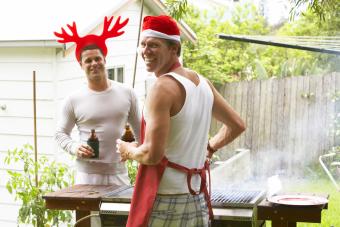
Christmas is a time for gathering, joy, and tradition. Every family and every culture seem to have their unique way of doing things during the holidays. If you want to work some atypical Christmas food traditions into your holiday meal, these ideas certainly hit the mark.
The Portuguese Feed the Dead
The Portuguese people partake in a traditional Christmas feast called consoada. The word consoada is derived from the Latin word consolare, which means "to comfort."
While this meal is traditional in this part of the world, those living in different pockets of Earth will find components of consoada pretty unique. During this meal, the Portuguese set places at the table for their deceased loved ones. The souls of the dead are given gifts of food in hopes of ensuring prosperity in the future. In some parts of the country, crumbs of food are left on the home's hearth. This is done thanks to the ancient practice of leaving seeds with the dead, hoping they will provide a bountiful harvest for the living. The
Consoada isn't the only unique food tradition that the Portuguese people observe. They also dine on a dessert dish called Aletria. This is an angel hair pasta dish that dates back hundreds of years. The pasta, which is covered in cinnamon and pomegranate seeds and cooked in sweetened milk, likely came from the Moors, who occupied Portuguese lands for hundreds of years.

Taking Fresh Fish to a New Level in the Czech Republic
In the Czech Republic, Christmas dinner is all about carp. This fish finds its way onto many Christmas dinner tables in this region of the world. Residents of the region go to markets and often purchase the carp out of bins, bring them home and allow them to swim around their bathtubs until it is time to slice, dish, and fry them up.
Fish farming began hundreds of years ago, in the 12th century, and the fish most commonly farmed was the carp. Before the 17th century, this dish was primarily reserved for the noble classes, with peasants feasting on simple foods like cabbage soup and other meatless, cost-effective meals. By the 19th century, however, carp consumption on Christmas day became widespread, thanks to writer Magdalena Dobromila Rettigová and her fried carp recipe.
Dine on KFC in Japan
Many people in America dine on ham or turkey during the winter holidays, but in Japan, it is chicken all the way. The Japanese don't consume any old chicken on December 25th. They spring for Kentucky Fried Chicken.
This unique food tradition came to be thanks to some seriously savvy marketing and a fascination with western culture. In the 1940s and 1950s, the Japanese economy experienced a surge as it had never before experienced. A few decades later, in the 1970s, the fast-food industry in Japan followed suit and exploded, expanding by an astounding 600%. KFC was one of the American chains that started popping up on just about every street corner in Japan. Over a ten-year span, Japan had 324 stores, and the franchise was making over 200 million dollars per year.
There was a lot of money to be made here, and KFC capitalized on this new fascination of fast food and westernization, which included the concept of Christmas. There are several stories as to how Christmas and KFC came together. One theory is that fried chicken was marketed as traditional American food, making it appealing to Japanese people who wanted to infuse their lives with American everything at the time. Another theory claims that KFC's first manager attended a party dressed as Santa, saw how well received it was, and put the ideas of chicken and Santa together. Regardless of what idea sparked the unique food tradition, it wasn't long before good old Colonel Sanders was standing outside in late December dressed as Santa and advertising delicious golden brown chicken drumsticks.
The keen advertising and marking ploys to push chicken during Christmas resulted in a massive sales boom that can still be seen in Japan today. The busiest business day for KFC in Japan is December 24th, where the fast-food franchise does 5-10 times the business it usually does.
Working this tradition into your own home is pretty simple. All you have to do is head out to KFC and order a bucket of chicken and some sides. Considering Christmas is a significant holiday in the western world, compared to China, where roughly 1% of the population observes Christmas, ordering on December 24th would be a smart move. Most Americans celebrating Christmas don't think of takeout food as a go-to holiday meal, but it makes sense. You can easily tailor the amount you need to feed guests with no work put in on your part, various sides can be added to orders to appease all palates, and the meal host doesn't have to slave away in the kitchen for two days putting together a holiday feast.

Dreaming of a Barbecue Christmas
BBQ for Christmas? Here in the western world, people would never think of lighting up the grill on December 25th. However, in New Zealand, a Christmas BBQ is what most people choose to do for their holiday dinner. In this part of the world, the holidays happen outdoors, as it is summertime in New Zealand during the holiday season. People get in the festive spirit by throwing charcoal on the barbie and spending the day in the sunshine.
Instead of large, heavy meals fireside, New Zealanders spend Christmas Day on the beach and in the yard, dining on grilled meats and complementary side dishes. New Zealanders approach Christmas in their own way, unique from other parts of the globe. Aside from a backyard BBQ Christmas dinner, they also have their own version of a Christmas tree and Christmas carols. Those who have Maori roots might put a dish called Hangi on the menu. This dish is comprised of fish, chicken, and potatoes, wrapped in flax leaves and cooked underground.

Christmas in Greenland Isn't Complete Without Kiviak
Kiviak is a traditional dish for the folks of Greenland, but it sounds truly unique to those who aren't from this part of the world. Kiviak is made from little sea birds that are housed in a hollowed-out seal carcass. The carcass is sealed up and rubbed in oil to prevent a maggot infestation. The rotting dish is left to do just that essentially. It gets placed seam-side up underneath a large rock and left there for the better part of a year so that the fermentation process can fully evolve. When it is time to break open the carcass, the birds are revealed. People eat them, bones and all, plucking the feathers off and digging in.
As unpalatable as this probably sounds, Kiviak is considered a delicacy in Greenland, and people there have been eating it since man first settled the area. The dish is now reserved for special occasions and holidays, but hundreds of years ago, it was the meal people counted on for their survival. When Greenland went utterly dark, and no farming or vegetation could be counted on, this dish met the nutritional needs of the people from the region.
Kiviak is generally eaten outdoors, regardless of the weather conditions, as it is one meal that will end up stinking the house up for weeks.
Norwegians Use Their Heads at Christmas Dinner
In Norway, those preparing Christmas dinner really use their heads, well, sheep heads, to be precise. Smalahove gets served up at Christmastime, and this is a unique Christmas dish that you likely won't feast on anywhere else in the world. Typically, the sheep's brains get removed, and the sheep's head is torched and fleeced. Are you feeling hungry yet? The sheep head then gets salted, dried, and boiled for three hours. After that, it is ready to be served with potatoes and turnips. Sometimes the brains are left inside the head, and after the cooking process is completed, they are scooped out and gobbled up with a spoon.
The true origins of this unique Christmas dinner dish are relatively unknown. What is known is that many centuries ago, the wealthy Norwegian people commonly dined on better parts of the sheep, leaving the less desirable components of the animal for those with fewer finances. One of these less desirable sheep parts was, of course, the head of the animal. Over the years, the dish grew from a meal for the poor to a delicacy in Norway.
If you are thinking of working a unique tradition like this into your Christmas meal, play on the sheep component. Think about starting with lamb dishes first, because going from Honeybaked Ham to a sheep head might make for one shocking holiday!

Make the Holidays Yours
Whether you stay the traditional course or you decide to work in unique Christmas traditions, make sure that the holiday season remains authentic to you. Incorporate aspects with meaning and intention and when things don't feel organic, toss them. Holidays like Christmas create memories that will last you a lifetime. Make them fun and interesting, keep what works and pitch what doesn't.







